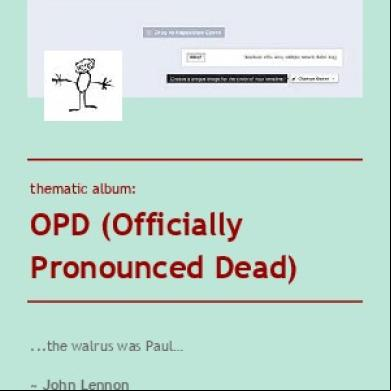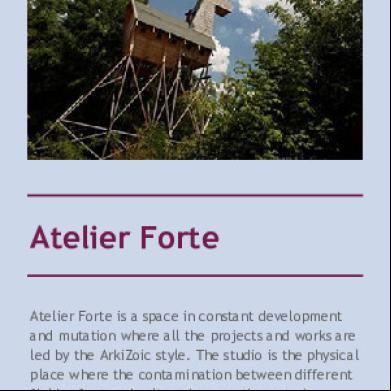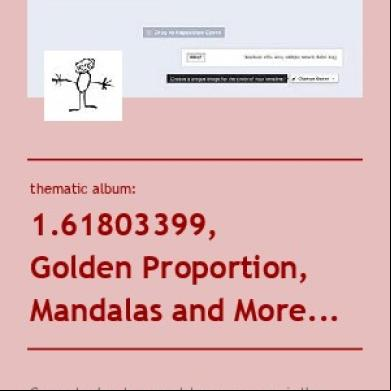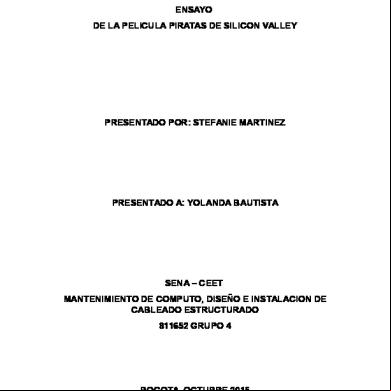Robots And Other Machines 4u4g6a
This document was ed by and they confirmed that they have the permission to share it. If you are author or own the copyright of this book, please report to us by using this report form. Report 3i3n4
Overview 26281t
& View Robots And Other Machines as PDF for free.
More details 6y5l6z
- Words: 812
- Pages: 18
Stefano Mirti’s facebook wall https://www.facebook.com/stefano.mirti. 3/media_set?set=a. 10150225482521216.316343.634251215&type=3
thematic album:
Robots and Other Machines A robot must protect its own existence as long as such protection does not conflict with the First or Second Law. ~ Isaac Asimov, The Third Law of Robotics
150/211
Kraftwerk 1970/ongoing
Stefano’s facebook album
Robots and Other Machines
150/211
Kraftwerk 1970/ongoing
Stefano’s facebook album
Robots and Other Machines
150/211
Kraftwerk 1970/ongoing
Stefano’s facebook album
Robots and Other Machines
150/211
Sumet Jumsai, Robot Building (Bank of Asia) Bangkok, 1986
Stefano’s facebook album
Robots and Other Machines
150/211
Sumet Jumsai, Robot Building (Bank of Asia) Bangkok, 1986
Stefano’s facebook album
Robots and Other Machines
150/211
Sumet Jumsai, Robot Building (Bank of Asia) Bangkok, 1986
Stefano’s facebook album
Robots and Other Machines
150/211
Boris Karloff in a Still from: James Whale, Frankenstein 1931
William Henry Pratt (November 23, 1887/February 2, 1969), better known by his stage name Boris Karloff, was an English actor. Karloff is best ed for his roles in horror films and his portrayal of Frankenstein's monster in Frankenstein (1931), Bride of Frankenstein (1935), and Son of Frankenstein (1939). His popularity following Frankenstein was such that for a brief time he was billed simply as "Karloff" or "Karloff the Uncanny". His best-known non-horror role is as the Grinch, as well as the narrator, in the animated television special of Dr. Seuss’s How the Grinch Stole Christmas! (1966). Stefano’s facebook album
Robots and Other Machines
150/211
Boris Karloff in a Still from: James Whale, Frankenstein 1931
Karloff is best ed for his roles in horror films and his portrayal of Frankenstein's monster in Frankenstein (1931), Bride of Frankenstein (1935), and Son of Frankenstein (1939). His popularity following Frankenstein was such that for a brief time he was billed simply as "Karloff" or "Karloff the Uncanny". His best-known non-horror role is as the Grinch, as well as the narrator, in the animated television special of Dr. Seuss’s How the Grinch Stole Christmas! (1966).
Stefano’s facebook album
Robots and Other Machines
150/211
Boris Karloff in a Still from: James Whale, Frankenstein 1931
Stefano’s facebook album
Robots and Other Machines
150/211
A Still from: James Whale, Frankenstein 1931
Stefano’s facebook album
Robots and Other Machines
150/211
Mikoláš Aleš, Rabi Loew and Golem 1899
“I am frustrated by the legend of the Golem in the same way I am frustrated that people buy Kafka souvenirs on every street in Prague but don’t bother to read his books.” Rabbi Karel Sidon, the chief rabbi of the Czech Republic.
Stefano’s facebook album
Robots and Other Machines
150/211
Michal Maňas, Statue of Clay Golem Depicting Prague Golem 2007
-photo taken in the Czech RepublicIn Prague, there are Golem hotels; Golem doormaking companies; Golem clay figurines (made in China); a recent musical starring a dancing Golem; and a Czech strongman called the Golem who bends iron bars with his teeth. The Golem has also infiltrated Czech cuisine: the menu at the nonkosher restaurant called the Golem features a “rabbi’s pocket of beef tenderloin” and a $7 “crisis special” of roast pork and potatoes that would surely have rattled the venerable Rabbi Judah Loew ben Bezalel, the Golem’s supposed maker. Stefano’s facebook album
Robots and Other Machines
150/211
Judah Loew Ben Bezalel Working on the Golem ca. 1520/September 17, 1609
-alt. Loewe, Löwe or LevaiLoewe, widely known to scholars of Judaism as the Maharal of Prague, or simply The MaHaRaL, the Hebrew acronym of "Moreinu ha-Rav Loew", ("Our Teacher, Rabbi Loew") was an important Talmudic scholar, Jewish mystic, and philosopher who served as a leading rabbi in the city of Prague in Bohemia for most of his life.
Stefano’s facebook album
Robots and Other Machines
150/211
Philippe Semeria, The Golem 2009
The Hebrew word for "Truth", one of the names of God, is written on his forehead.
Stefano’s facebook album
Robots and Other Machines
150/211
Unknown Author, Reproduction of the Prague Golem 2007
Eva Bergerova, a theater director who is staging a play about the Golem, said it was no coincidence that this Central European story was ubiquitous at a time of swine flu and economic distress. “The Golem starts wandering the streets during times of crises, when people are worried”, Ms. Bergerova said. “He is a projection of society’s neuroses, a symbol of our fears and concerns. He is the ultimate crisis monster.”
Stefano’s facebook album
Robots and Other Machines
150/211
Unknown Author, Rabbi Loewe and the Golem 2007
The surge in popularity of the Golem also anticipated the 400th anniversary in September of Rabbi Loew’s death in 1609, at nearly 100. A Jewish mystic and philosopher who a leading scholar of the Talmud and kabbalah and wrote at least 22 books, he was known widely as the Maharal, a great sage.
Stefano’s facebook album
Robots and Other Machines
150/211
John Casey, The Golem
Text and more from: http://www.nytimes. com/2009/05/11/world/europe/11golem.html
Stefano’s facebook album
Robots and Other Machines
150/211
thematic album:
Robots and Other Machines A robot must protect its own existence as long as such protection does not conflict with the First or Second Law. ~ Isaac Asimov, The Third Law of Robotics
150/211
Kraftwerk 1970/ongoing
Stefano’s facebook album
Robots and Other Machines
150/211
Kraftwerk 1970/ongoing
Stefano’s facebook album
Robots and Other Machines
150/211
Kraftwerk 1970/ongoing
Stefano’s facebook album
Robots and Other Machines
150/211
Sumet Jumsai, Robot Building (Bank of Asia) Bangkok, 1986
Stefano’s facebook album
Robots and Other Machines
150/211
Sumet Jumsai, Robot Building (Bank of Asia) Bangkok, 1986
Stefano’s facebook album
Robots and Other Machines
150/211
Sumet Jumsai, Robot Building (Bank of Asia) Bangkok, 1986
Stefano’s facebook album
Robots and Other Machines
150/211
Boris Karloff in a Still from: James Whale, Frankenstein 1931
William Henry Pratt (November 23, 1887/February 2, 1969), better known by his stage name Boris Karloff, was an English actor. Karloff is best ed for his roles in horror films and his portrayal of Frankenstein's monster in Frankenstein (1931), Bride of Frankenstein (1935), and Son of Frankenstein (1939). His popularity following Frankenstein was such that for a brief time he was billed simply as "Karloff" or "Karloff the Uncanny". His best-known non-horror role is as the Grinch, as well as the narrator, in the animated television special of Dr. Seuss’s How the Grinch Stole Christmas! (1966). Stefano’s facebook album
Robots and Other Machines
150/211
Boris Karloff in a Still from: James Whale, Frankenstein 1931
Karloff is best ed for his roles in horror films and his portrayal of Frankenstein's monster in Frankenstein (1931), Bride of Frankenstein (1935), and Son of Frankenstein (1939). His popularity following Frankenstein was such that for a brief time he was billed simply as "Karloff" or "Karloff the Uncanny". His best-known non-horror role is as the Grinch, as well as the narrator, in the animated television special of Dr. Seuss’s How the Grinch Stole Christmas! (1966).
Stefano’s facebook album
Robots and Other Machines
150/211
Boris Karloff in a Still from: James Whale, Frankenstein 1931
Stefano’s facebook album
Robots and Other Machines
150/211
A Still from: James Whale, Frankenstein 1931
Stefano’s facebook album
Robots and Other Machines
150/211
Mikoláš Aleš, Rabi Loew and Golem 1899
“I am frustrated by the legend of the Golem in the same way I am frustrated that people buy Kafka souvenirs on every street in Prague but don’t bother to read his books.” Rabbi Karel Sidon, the chief rabbi of the Czech Republic.
Stefano’s facebook album
Robots and Other Machines
150/211
Michal Maňas, Statue of Clay Golem Depicting Prague Golem 2007
-photo taken in the Czech RepublicIn Prague, there are Golem hotels; Golem doormaking companies; Golem clay figurines (made in China); a recent musical starring a dancing Golem; and a Czech strongman called the Golem who bends iron bars with his teeth. The Golem has also infiltrated Czech cuisine: the menu at the nonkosher restaurant called the Golem features a “rabbi’s pocket of beef tenderloin” and a $7 “crisis special” of roast pork and potatoes that would surely have rattled the venerable Rabbi Judah Loew ben Bezalel, the Golem’s supposed maker. Stefano’s facebook album
Robots and Other Machines
150/211
Judah Loew Ben Bezalel Working on the Golem ca. 1520/September 17, 1609
-alt. Loewe, Löwe or LevaiLoewe, widely known to scholars of Judaism as the Maharal of Prague, or simply The MaHaRaL, the Hebrew acronym of "Moreinu ha-Rav Loew", ("Our Teacher, Rabbi Loew") was an important Talmudic scholar, Jewish mystic, and philosopher who served as a leading rabbi in the city of Prague in Bohemia for most of his life.
Stefano’s facebook album
Robots and Other Machines
150/211
Philippe Semeria, The Golem 2009
The Hebrew word for "Truth", one of the names of God, is written on his forehead.
Stefano’s facebook album
Robots and Other Machines
150/211
Unknown Author, Reproduction of the Prague Golem 2007
Eva Bergerova, a theater director who is staging a play about the Golem, said it was no coincidence that this Central European story was ubiquitous at a time of swine flu and economic distress. “The Golem starts wandering the streets during times of crises, when people are worried”, Ms. Bergerova said. “He is a projection of society’s neuroses, a symbol of our fears and concerns. He is the ultimate crisis monster.”
Stefano’s facebook album
Robots and Other Machines
150/211
Unknown Author, Rabbi Loewe and the Golem 2007
The surge in popularity of the Golem also anticipated the 400th anniversary in September of Rabbi Loew’s death in 1609, at nearly 100. A Jewish mystic and philosopher who a leading scholar of the Talmud and kabbalah and wrote at least 22 books, he was known widely as the Maharal, a great sage.
Stefano’s facebook album
Robots and Other Machines
150/211
John Casey, The Golem
Text and more from: http://www.nytimes. com/2009/05/11/world/europe/11golem.html
Stefano’s facebook album
Robots and Other Machines
150/211










